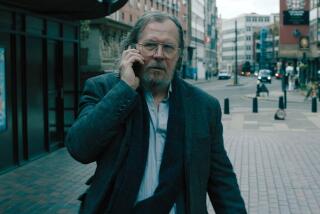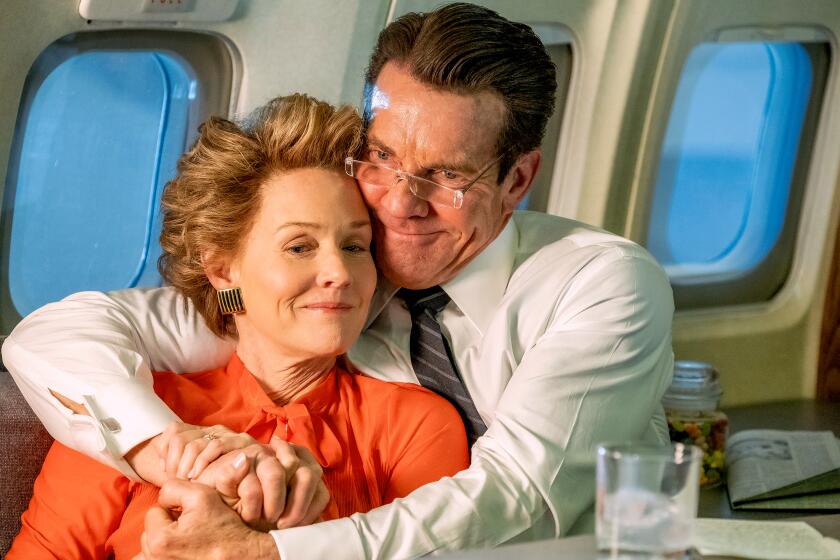Stallone Tries a New Beat in ‘Cop Land’
“Stallone Acts!” may not resonate the way “Garbo Talks!” did once upon a time, but it’s the main attraction of “Cop Land,” an independently produced police drama whose entire budget is close to Sly’s usual salary for the brawny epics that are his specialty.
Determined to return to his “Rocky/Lords of Flatbush” roots and a less exclusively physical style of acting, Stallone not only took a considerable pay cut here, he also gained so much weight (a reported 39 pounds) for the part that a shot of him looking especially paunchy had to be cut after it pulled preview audiences right out of the picture.
Written and directed by James Mangold, who debuted with the Sundance hit “Heavy,” “Cop Land” also takes the precaution of surrounding Stallone with Harvey Keitel, Ray Liotta, Robert De Niro, Peter Berg and Michael Rapaport, a coterie of actors who have been down this particular road before.
The result is familiar territory, one of those hard-case movies where the guys talk tough and the women are long-suffering. Like Stallone’s much-anticipated performance, “Cop Land” is involving in individual moments but not compelling as a whole. Always watchable, it ends up promising more than it can deliver, an independent film that can’t camouflage its too-schematic Hollywood soul.
Cop Land is not a state of mind, it’s a place, a town called Garrison, N.J., that’s just over the George Washington Bridge from Manhattan. It’s an enclave inhabited almost exclusively by New York cops and their families, guys who took advantage of a loophole to flee the city’s criminal element and get a little fresh air in the bargain.
Not just anyone can be the law in a town full of lawmen; the job apparently calls for an ineffectual dupe washed up before his time, someone for whom pride and ambition are just a memory. Ray Donlan (Keitel), the man to see in Cop Land, knows he’s found the perfect candidate in Sheriff Freddy Heflin (Stallone).
An NYPD wannabe whose bad ear, damaged in an underwater rescue years before, has kept him off the force, Heflin is a wistful lost soul with a big gut and a sad sack attitude, the kind of guy who spends his days returning lost stuffed animals to their owners and his nights dozing off to Springsteen melodies.
Most of the cops in Garrison barely notice the sheriff, and some, like Joey Randone (Berg), who married Liz (Annabella Sciorra), the woman whom Heflin rescued and still loves, hold him in contempt. Only the troubled Gary Figgis (Liotta), prone to sticking darts up people’s noses when he gets upset, tolerates the big lug and thinks he’s worth treating decently.
Heflin’s lethargic existence gets shaken up after an incident on the George Washington Bridge. Murray “Superboy” Babitch (Rapaport), a cop who is Ray Donlan’s nephew, gets into an altercation so serious that the young man has to be made to disappear. No one’s supposed to know where Superboy is, but a quirk of fate reveals that information to the sheriff.
Complicating things even more is the appearance in Garrison of Moe Tilden (De Niro), a determined investigator from the NYPD’s Internal Affairs section. He’s suspicious of Babitch’s disappearance and focuses on the sheriff as the weak link in the wall of silence. “I see a man waiting for something to do,” Tilden tells Heflin, but the sheriff, a Sampson with his hair still shorn, turns him down. For now.
When as public an actor as Sylvester Stallone takes a new career turn, it’s tempting to talk about it in extremes, to flatly say he shouldn’t have bothered or to instruct Daniel Day Lewis to look to his laurels. In this case, however, neither position is accurate.
Well-cast and looking especially woebegone with a bandage on his nose for most of the picture, Stallone gives a solid, capable performance as the flabby sheriff, but it’s rather on the one-note side and lacks the charisma of his best roles. He has no trouble holding his own with his co-stars, but seems a bit rusty, and he doesn’t bring as much to the table as he might.
As to those other actors, they’ve done this kind of work so often it’s to Mangold’s credit that things don’t become completely routine. As a director, he shows his people to their best advantage and is especially good at heightening individual moments, like the scene in which De Niro’s Tilden says he’s visiting all-police Garrison because “I heard it was a way of life,” and Keitel’s Donlan snaps back, “What are we, the Amish now?”
But if the film’s many sharp scenes make a fine attractions reel, they do not come together in a satisfying way. “Cop Land’s” script has so many contrivances, coincidences, dark secrets and last-minute changes of heart that its plot starts to resemble the standard Hollywood nonsense its star is nominally trying to flee. While Stallone’s return to simpler fare is successful enough to have been worth doing and worth repeating, it would be wishful thinking to call it or the film it inhabits unqualified successes.
* MPAA rating: R, for violence, strong language and brief nudity. Times guidelines: A character attempts to rip another character’s nose off with a dart.
‘Cop Land’
Sylvester Stallone: Freddy Heflin
Harvey Keitel: Ray Donlan
Ray Liotta: Gary Figgis
Robert De Niro: Moe Tilden
Peter Berg: Joey Randone
Janeane Garofalo: Deputy Cindy Betts
Robert Patrick: Jack Rucker
Michael Rapaport: Murray Babitch
Annabella Sciorra: Liz Randone
A Woods Entertainment production, released by Miramax Films. Director James Mangold. Producers Cary Woods, Cathy Konrad, Ezra Swerdlow. Executive producers Bob Weinstein, Harvey Weinstein, Maryl Poster. Screenplay James Mangold. Cinematographer Eric Edwards. Editor Craig McKay. Costumes Ellen Lutter. Music Howard Shore. Production design Lester Cohen. Art director Wing Lee. Set decorator Karin Weisel. Running time: 1 hour, 40 minutes.
* In general release throughout Southern California.
More to Read
Only good movies
Get the Indie Focus newsletter, Mark Olsen's weekly guide to the world of cinema.
You may occasionally receive promotional content from the Los Angeles Times.











